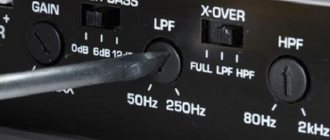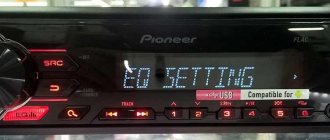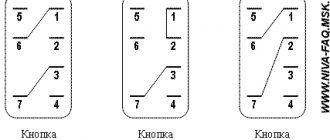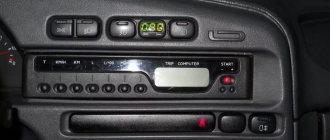HPF / LPF (HPF / LPF)
Hight pass filter (HPF), also known as a high-pass filter (HPF), filters out (cuts off) low frequencies, leaving high ones.
When setting up a subwoofer amplifier, set the control to about 20 Hz to cut out infrasound and not waste energy, since you won't hear it anyway. For mid-range speakers, the HPF is set around 80 Hz to remove the low frequency range for which the speaker is not designed and will not be able to play it. If you have separate channels or even a separate amplifier for tweeters (tweeters), the HPF is set in the region of 3000 - 5000 Hz, depending on the model, so as not to burn them.
All figures given are approximate, to obtain more accurate and safe values, study the characteristics of your speakers!
Low pass filter (LPF), also known as a low pass filter (LPF), is the opposite of HPF and cuts off the upper frequencies, leaving the lower ones.
For subwoofers, it is set in the region of 50-80 Hz, depending on the type of design (ZYA, FI, etc.) in order to cut off frequencies for which the subwoofer is not intended. The same goes for midrange drivers, cut them around 1400-1600 Hz.
If possible, you can limit tweeters to 20,000 Hz, but this is not necessary.
Setting up an amplifier for a subwoofer
In order to get good and powerful bass sound, owners of passive subwoofers purchase a separate low-frequency amplifier. Some models are designed only to work with the low-frequency path, but many install a multi-channel unit that allows you to change for the better the sound of all speaker systems in the car.
ULFs designed to work with subwoofers have a number of adjustments that can be changed, adjusting the amplifier to a specific type of speaker and the configuration of the car interior. Factory settings are usually in the middle position, which is not always correct for reproducing low frequencies with a specific loudspeaker.
Gain Level
Gain (sensitivity) is often confused with volume, but this is not entirely correct.
Gain is an adjustment of the amplifier's input sensitivity to match the radio. But let’s not get into the weeds and consider this setting from the point of view of what is useful for the user.
Sometimes the Volts (V) value indicated on the regulator can be misleading. The fact is that sensitivity is measured in Volts. The smaller V, the higher the sensitivity, the louder the speaker will play and vice versa.
To begin with, it will be useful to watch a clear video about how gain works on an amplifier:
Adjusting gain by ear (method 1)
Having a good sub link, do not use an equalizer and various bass enhancers, forget about bassboost on the amplifier - so before adjusting the gain, make sure that all this is turned off!
Set the control to minimum and play music that you usually listen to. Turn up the volume of the radio by 3/4 of the maximum; if you hear distortions in the sound of the subwoofer earlier, stop and turn down the volume a couple of notches. Go to the amplifier. Have an assistant slowly turn up the gain control until new distortion appears, and when you hear it, stop the rotation and turn it down by 10%.
Adjusting gain by ear (method 2)
If you don’t trust your hearing and are afraid not to hear changes during time, then use a more accurate method - using sinuses.
If you are tuning a subwoofer, then use 40 Hz, if your case is tuned above 40 Hz or you have a closed box, then take 50 Hz (download sines in the Downloads section). To set the gain for the midbass amp, use 315 Hz.
Sine or tone (in our case) is a tone signal of a certain frequency, changes in the sound of which you can easily hear
Set the gain to minimum, turn on your sine and turn up the volume of the radio. When changing the sound of the tone signal, stop and turn it down a couple of notches (set the maximum volume limit to this value if your radio has such a function). Go to the amplifier. Similarly to the first method, add gain. When the sound changes, stop and turn it down 10%.
Adjusting Gain Using a Multimeter or Oscilloscope
Adjusting the gain level using instruments is a smart and precise adjustment. At the same time, neither the speaker nor your ears are strained. This setup is shown in detail in the video on our YouTube channel:
How to connect the front through an amplifier – AutoTop
The three-band front allows you to increase the volume, improve the detail of the car audio system, and the subwoofer will complement the lack of lower register, to complete the sound picture. In the “Three-way front and subwoofer” system, the full sound band is divided into four types of emitters (speakers), as a result, each speaker reproduces a narrower range than in the “two-way front and subwoofer” system or in systems with wide-range speakers, respectively, speakers in three-band front are less loaded and therefore can play louder and more accurately. I present to your attention the two most popular schemes for organizing a three-way front and subwoofer.
-The first scheme is a three-band front on passive crossovers. In this system, great attention must be paid to the installation, placement and direction of the speakers. The “three-way front and subwoofer” system is configured similarly to the “two-way front and subwoofer” system - the top of the subwoofer and the bottom of the midbass are matched, and the sensitivity of the amplifier’s input signal (Gain) is set accordingly. -The second system uses channel-by-channel amplification from the processor radio, using a little trick.
The trick is that most processor-based radios have three pairs of preamplifiers, and in order to properly set up a three-band front with a subwoofer and make the necessary delays, you need four pairs. This is only available in top radios, for example in the Pioneer DEX-P99RS, but not everyone can afford it. Therefore, the right midbass RCA is divided using two Y-splitters and tunes the system quite adequately. Why exactly the right midbass channel, because in terms of distance from the driver’s ears, the right midbass is approximately the same distance as the subwoofer.
By setting the time delay for the right midbass, we get approximately the required delay on the subwoofer.
Setting up a “three-way front and subwoofer” system connected per channel is quite complicated - the cutoffs are set for each type of speaker, different crossover cutoff slopes are used, individual sound delays for each speaker, plus tonal balance. For an inexperienced person, setting it up correctly is practically impossible, fortunately there is a GU, which comes with a calibration microphone, which will partially help set up the system
source
Connecting interconnect wires and control (REM)
To lay the cable, you need to find the linear output on the radio. The linear output can be recognized by the characteristic “bells” that are located on the rear panel of the radio. The number of linear outputs differs in different radio models. Usually there are from one to three pairs.
Basically they are distributed as follows: 1 pair - you can connect a subwoofer or 2 speakers (labeled as SWF) If there are 2 pairs of them, you can connect 4 speakers or a subwoofer and 2 speakers (outputs are labeled F and SW), and when there are 3 pairs of linear wires on the radio, you can connect 4 speakers and a subwoofer (F, R, SW) F This is Front i.e.
front speakers, R Read rear speakers, and SW Sabwoorer, I think everyone understands that.
The connection will require an interconnect wire, which should never be skimped on. It is prohibited to lay the interconnect cable near the power wires, as various types of noise will be heard when the engine is running. You can run the wires both under the floor mats and under the ceiling. The latter option is especially relevant for modern cars, in the interior of which there are electronic accessories that create interference.
You also need to connect the control wire (REM). As a rule, it comes with interblock wires, but it happens that it is not there, purchase it separately; it does not need to be of a large cross-section - 1 mm2 is quite enough. This wire serves as a control for turning on the amplifier, i.e. when you turn off the radio, it automatically turns on your amplifier or subwoofer. As a rule, this wire on the radio is blue with a white stripe; if it is not there, use a blue wire. It is connected to the amplifier to a terminal called REM.
Connecting a two-channel and four-channel amplifier
We have combined this section because these amplifiers have a very similar connection diagram, one might even say more simply, a four-channel amplifier is two two-channel ones. We will not consider connecting a two-channel amplifier, but if you figure out how to connect a four-channel amplifier, then you will not have any problems connecting a two-channel amplifier. Most car enthusiasts choose this option for their installations, since this amplifier can connect 4 speakers, or 2 speakers and a subwoofer. Let's look at connecting a four-channel amplifier using the first and second options.
Source: https://QcySound.ru/shemy-ustrojstv/kak-pravilno-podklyuchat-front.html
Bassboost
Bassboost - increases the volume at a certain frequency, usually 40-45 Hz.
When using a bass boost, the chance of burning the subwoofer increases sharply, since clipping occurs much earlier. In most cases, bassboost is not needed and if you are a beginner, then just accept the rule “Don’t touch bassboost!”
Experienced people can use it to increase the frequency response shelf in order to draw out dips in certain frequencies, but these are already deep settings and the effect does not always justify the risk.
Subsonic
Subsonic is the same high pass filter (HPF) on sub amplifiers (often on monoblocks) - it cuts off infrasound. Set it by default to around 20-25 Hz. With in-depth tuning, the subsonic is set to prevent excessive diffuser travel. The sines below the tuning frequency of the subwoofer body are turned on one by one and the desired value is selected by observing the diffuser stroke value.
What to collect from?
You should carefully select components. There are many selection criteria other than the sound of certain brands. Be sure to take into account the dimensions depending on the intended location of the audio system. Just in case, select parts with at least two pairs of linear outputs. And look at the appearance: the design should be combined with the interior of the cabin.
Once you decide on the sound, pay attention to the place where you are going to put it. Dimensions and installation depth play a huge role when installing the system. The optimal choice is two-component speakers from a well-known brand.
Lately, door podiums have become quite popular. True, the “filling” of the door and its trim often take a long time to adjust to the purchased components.
Speakers aren't everything
The choice of a subwoofer is determined by the same criteria as acoustics: diameter, installation depth and sound feature. Therefore, the advice related to acoustics will also apply to the subwoofer.
An amplifier is an essential element of any audio system. Your choice should fall on a renowned company. These, as a rule, are made of more resistant materials and high-quality components, and can also withstand increased loads.
Red or blue?
Don't forget about the wires! Wires are divided into three types: acoustic, interconnect and power. Power ones are needed to connect the head unit and amplifier and the power source. There is an opinion that the more expensive the better. In our case, this is true only for wires of the highest price category. Daxx, Stinger, Belsis and Chernov wires perform well.
Sometimes a capacitor is added to the system to eliminate bass sag when there is insufficient power from the generator and battery. You may encounter such situations if, for example, you are going to participate in car audio competitions. Please note that for a power of 500W, 0.5F is enough. Focus on models with automation if you don’t want to bother with connections. If you are making a system “for yourself,” a capacitor is not needed.
Scheme development
The connection diagram depends on the number of amplifier inputs, the location and power of the speakers, and the presence or absence of a subwoofer.
Power amplifiers are:
- two-channel, designed to connect only a pair of speakers;
- four-, used to connect two speakers and a subwoofer or four (there is also a daisy chain connection scheme for four speakers and a subwoofer);
- six-, used for a standard connection of four pieces and a subwoofer.
It is also important to consider the rated power (W, W) and the resistance of all connected equipment (Ohm). They can be found either on device labels or in technical documents. The total connection resistance should not exceed the maximum permissible standard.
There are three ways to connect speakers to an amplifier.
- Sequentially—speakers of the same type are alternately connected to each other and then to the device.
- Parallel - performed by a polar connection directly to the outputs of the device, while their resistance and power may differ.
- Series-parallel - used in cases where it is necessary to connect two columns with the same resistance and additional ones with other parameters.
Find out in advance what you need
Before purchasing components, be sure to determine the wiring diagram. It determines exactly what you need, as well as a theoretical price range. The following are the most common and convenient schemes.
- Head unit - front subwoofer - 4-channel amplifier for front and subwoofer.
Classic. Budget-friendly, easy to install and configure. It is also good because it saves space in the car. The disadvantages include the low power of the system, but this does not significantly affect the sound quality. - Head unit - front - rear - subwoofer - 5-channel amplifier for front, rear and subwoofer.
It is based on the previous scheme. It differs only in that it provides sound in the rear part of the cabin. The setup is more difficult than the first scheme, and it is not always possible to achieve the desired result. - Head unit - front - subwoofer - 2-channel amplifier to the front - 2-channel amplifier to the subwoofer.
Do you like powerful bass? Then this diagram is for you. We get more power by connecting a two-channel amplifier to a subwoofer with a bridge. - Head unit - front - subwoofer - 4-channel amplifier for the front - 2-channel amplifier for the subwoofer.
The most expensive of the presented schemes. And the best. Sound quality and power are achieved through channel-by-channel amplification.
DIY setup without a subwoofer
In this case, the speaker system consists of four speakers. In this option, the settings will be the simplest. With this design, the amplifier filters are disabled. All parameters are set to zero, and the crossover selector is set to the “Flat” position. With these settings, the speaker, amplifier and all other components will produce high-quality sound without distortion.
All that remains is to expose the head unit. This can be done by selecting from ready-made equalizer settings. The volume is turned up to 90 percent and the track starts. During the sound process, the gain is adjusted until the sound is loud and clear, without distortion. This is how you can set up a simple amplifier for the average music lover.
We collect
First, you should do the wiring. We select the cross-section of the power wire corresponding to the total power of the amplifier and head unit. We pull the plus and minus into the interior. Remember: wires passing through metal must be covered with a piece of plastic or rubber tubing to avoid a short circuit to ground.
The positive wire must be connected through a bulb with a fuse whose rating corresponds to the fuse on the amplifier. The flask must be positioned no further than 30 cm from the battery.
Run the power wires through the power distributor to the head unit and amplifier. They should be soldered to the head unit wiring harness, run the positive wire through the plug fuse. Protect the solder joint with heat shrink casing. Connect the block to the head unit, the interconnect wires to its linear outputs and install it in its original place according to the attached instructions. Crimp the ends of the power wire going to the amplifier with terminals.
Important!
It is better to run all wires separately from each other, although an intersection of 90 degrees is allowed.
Pay attention to the location
Place the high-frequency speakers on the lining of the windshield pillars, approximately at eye level and turn them towards the glass. So, they will work as a reflection, creating the width and height of the sound stage. To put it simply: we point the left speaker towards the passenger seat, the right one towards the driver’s seat.
When you're done connecting, double-check that everything is correct. After that, turn on the head unit and you can start setting up.
Connect the amplifier and install the subwoofer. If you have a sedan, then turn the sub towards the back of the passenger seats. If it’s a hatchback or station wagon, then go to the fifth door. Now you can connect the subwoofer!
Good nutrition is the key to success
The amplifier connection procedure begins with the power wires. Wiring is the most important element of a car audio system; the volume and sound quality depend on it. Amplifiers need a stable power supply, otherwise the power will not be enough and the sound will become distorted. To understand why you need to pay attention to the quality of wiring and how it affects the sound reproduced by a loudspeaker, you need to know what a music signal is.
Some suggest that it represents a sine wave, however, the musical sinhala is characterized by a large difference between the normal and peak value. If sharp signal bursts are not important for car speakers, then in the case of an amplifier the situation is completely different. If the signal exceeds the permissible power for even a second (or even a millisecond), then these “anomalies” will be audible even to those who cannot boast of a good ear for music.
If the car amplifier is connected properly, the signal will flow through the wires undistorted. Carelessly done work or incorrectly selected wire cross-section will result in the sound being more compressed, rough and sluggish. In some cases, wheezing may also be clearly audible.
How to choose a wire cross-section?
Wire is the most common metal with a certain level of resistance. The thicker the wire, the lower the resistance of the wire. To avoid sound distortion during large voltage fluctuations (for example, when playing powerful bass), you must install the correct gauge wire.
It is worth noting that the cross-section of the positive cable should not be larger than the negative one (the length does not matter).
An amplifier is considered to be a rather electrically intensive device. For its effective operation, high-quality grounding is necessary so that it is possible to receive the necessary energy from the battery. To choose the correct wire cross-section, you need to make some calculations. First, look at the instructions for the amplifier (or directly at the box from the manufacturer, if there is no documentation, use the Internet) and find the rated power value (RMS) there. Rated power is the signal power an amplifier can deliver over an extended period of time to one channel of 4 ohms.
If we consider four-channel amplifiers, they usually have a power of 40 to 150 watts per channel. Let's say that the amplifier you purchased produces 80 watts of power. As a result of simple mathematical operations, we find out that the total power of the amplifier is 320 W. Those. How did we calculate this? It’s very simple to multiply the rated power by the number of channels. If we have a two-channel amplifier with a rated power (RMS) of 60 W, then the total will be 120 W.
Setting details
After connection, the installed system must be properly configured. Tuning means setting the cutoff frequencies for acoustics and subwoofer on the amplifier, setting the incoming and outgoing sensitivity. As well as setting up the sound processor, if available.
Imagine that the filters in the amplifier are better than those in the head unit. And set all settings on the head unit to 0.
- Set the filter for the subwoofer channel to “LPF”. Set the crossover cutoff frequency from 50 to 70 Hz.
- Front channel filter to “HPF” position. The frequency is also in the range of 50-70 Hz.
- Adjust the sensitivity as follows: on the amplifier set the setting to “0”, on the head unit increase the volume to the maximum value. Then turn the sensitivity control on the amplifier upward until noticeable distortion appears in the sound of the system. Turn it down and the sensitivity is adjusted.
Important!
If the bass is localized on the subwoofer, then it should be connected in antiphase: turn the phase adjustment knob 180 degrees. If it is not there, swap the “+” and “-” in the subwoofer connection.
Launch everything and listen. If, when you start the radio, you hear clicks in the subwoofer and crackling sounds in the speakers, then check the wiring and, if necessary, rewire.
Setting up an amplifier for the front: how to connect via, step-by-step instructions
Many car owners do not know what tuning an amplifier to the front is. There are several options for self-adjustment. The choice of method depends on the needs of the driver.
What is front amplifier
Before connecting the front of the amplifier, you must carefully examine the panel. This will help determine the output to the subwoofers. There are anterior and posterior channels. The first ones are designated by the inscription REAR. The latter have a FRONT pointer. Rear channels are often called rear channels. The front is an amplifier for multi-channel audio systems.
How to connect the front
To connect the front through an amplifier, follow the step-by-step instructions. It consists of several successive stages. Otherwise, problems may arise if the car owner connects the system to the output of the rear speakers:
Which radio do you recommend buying?
- 4734 votes - 50% of all
- 1366 - 14% of all
- 1042 votes - 11% of all
- 814 - 9% of all
- 640 - 7% of all
- Other... 4%, 369 369 - 4% of all
- 151 votes - 2% of all
- 2%, 147 147 - 2% of all
- 141 votes - 1% of all
- 93 votes - 1% of all
- Include wiring from the audio system speakers with the required connectors at the front.
- Connect the radio by connecting the required cable to the player in the car.
- Distributes a sound signal. The amplifier must independently supply a pulse to the subwoofer and high-frequency speakers. The same applies to mid-range speakers.
Connecting the front through an amplifier will help you adjust the desired parameters of the device. This will be extremely easy to do. Before setting up, you need to decide on the control options during the connection process. Each amplifier has a Crossover Selector. It is designed to switch filters. When the device operates in the LP position, it operates at low frequencies.
Are you a car driver?! Then you can take this simple test and find out... Go to the test »
If you connect the AP, the amplifier is with modifications deactivated. There is a special regulator on the rear panel. It is used to change frequencies at the cutoff of filters. The power is adjusted by using Level. It will allow you to select the desired level. Bass Boost enhances low frequencies.
How to set up the front
The initial adjustment of the edge on the amplifier involves adjusting the crossovers and frequency level. The reason for the enhancement does not matter. To configure the amplifier taking into account the front parameters, you need to disable modifications and sound adjustments. When this is not possible, the sound control is set to zero. It is advisable for motorists to take into account that 2 procedures cannot lead to the same result.
Passive crossovers are set to medium high-frequency power. A similar action will be needed when turning off RF signals other than 0. When adjusting, set the value to 3 dB. For the low-pass filter of active crossovers, the indicators are adjusted to the same values. They range from 75 to 80 dB.
The sound gain on the channels should be at a minimum level.
The value is preferably the same as on acoustics. Completing all steps involves adjusting the connected amplifier to the connected setup to the front.
After the necessary preparation, the input sensitivity of the system is adjusted. If you follow the included guide, you may notice an incorrect ratio. Therefore, they set the indicator based on personal feelings. However, you should not choose the maximum level. The gain value is reduced to reduce the volume headroom. This allows for better sound quality.
To determine the correct gain value, it is recommended to listen to music. Then the setup will be more effective. In individual audio files, the value is increased until sound distortion appears. Then the indicator is reduced. For high volume, the level of noise occurrence is determined. After completing the gain adjustment, proceed to setting the subwoofer.
To configure channels, connect the wire from the installation to REAR. The front speakers are connected with a cable to the connectors. Then set the low frequencies to zero. It should be the same for both subwoofer channels.
Finally, the speaker crossover is installed on the HP. To adjust REAR, select the LP mode. Then the phase setting parameter is changed. This will make the sound more harmonious.
You may also like
Source: https://omagnitolah.ru/podklyuchenie/usilitelya-pod-front.html
Parallel-serial connection diagram
This is the most popular connection method, as it allows you to regulate the power supplied to the device and avoid overloading it. This results in high-quality sound. This connection scheme combines both methods.
Step-by-step instructions for connecting four speakers to two channels of the device.
- The negative terminal of speaker 1 is connected to the positive terminal of speaker 2.
- Negative contact 3 is connected to positive
- Positive contact 1 is output to a common positive channel with positive contact 3.
- Negative contacts 2 and 4 are connected to a common negative contact.
- The derived common channels are connected to the amplifier, taking into account the polarity of the contacts.
In the same way, subwoofers can be connected to this system if two-channel equipment is used. With four channels, the subwoofers are connected separately by a bridge.
Watch the connection video











